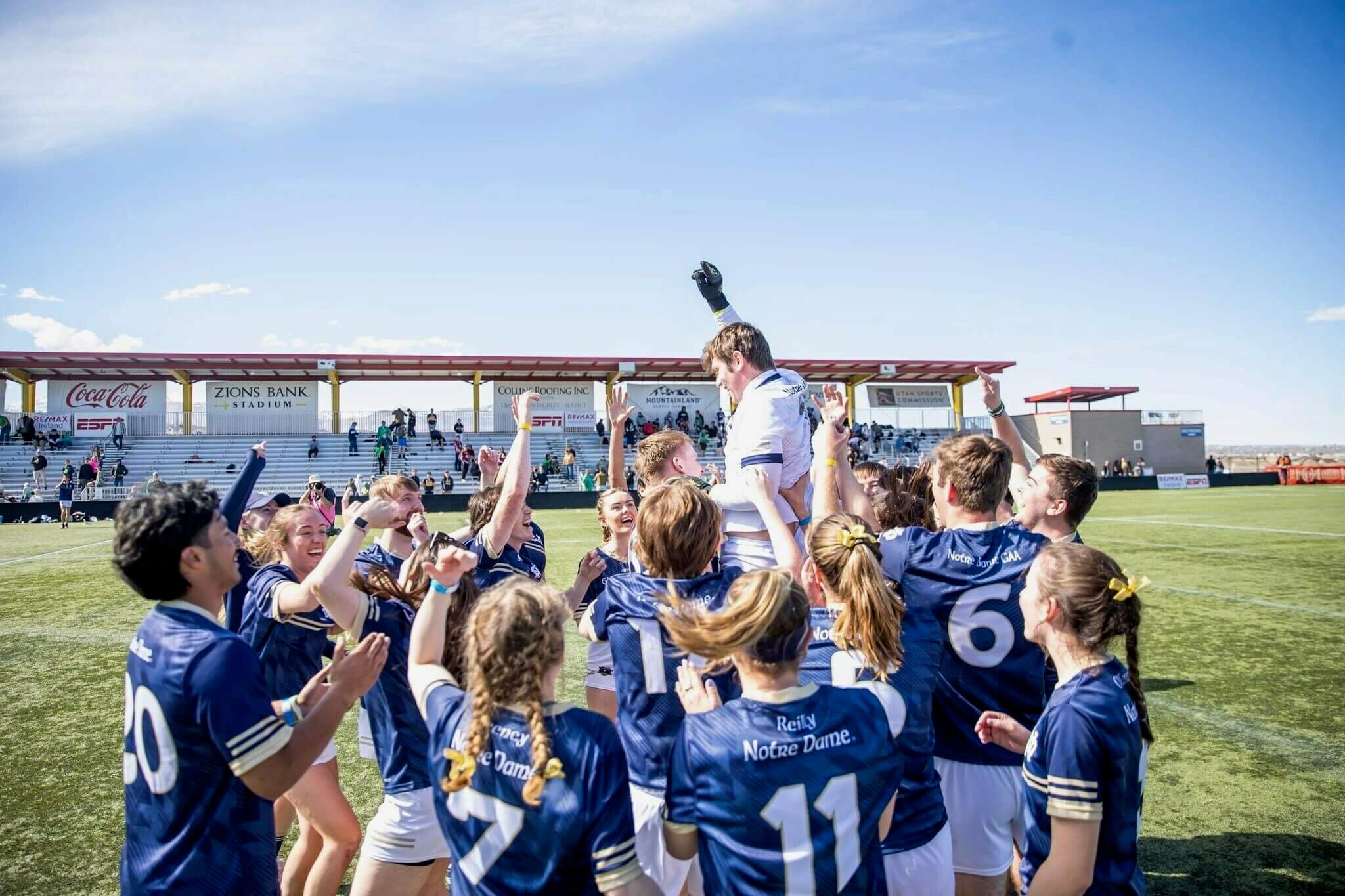The Notre Dame Gaelic Athletic Association (GAA) took the field at Zion Banks Stadium in Herriman, Utah, against Navy for the final Gaelic football match of the national tournament. It was St. Patrick’s Day, with the sound of bagpipes and cheers of spectators wearing green echoing against the mountains rising in the background. A perfect enviroment for the Fighting Irish to secure their third consecutive national title.
The three-peat is a testament to the team’s growth over the past six years. The co-ed club began with a small group of Irish-born students on campus in 2018, including Fintan Birch ’21, who wanted to bring central elements of Irish culture to Notre Dame. What began as a scraggly group of students donning makeshift T-shirts adorned with duct tape numbers has evolved into a team of American and Irish students proudly clad in authentic Gaelic football jerseys — “kits” in the lingo of Ireland.
The club participates in two popular Irish sports: hurling and Gaelic football. Senior Maggie O’Connell ’24, from Rockville Centre, New York, explains that hurling, a combination of lacrosse, baseball and field hockey, is played with an ash wood stick and a ball called a sliotar. Gaelic football blends elements of rugby and soccer.
For senior president Owen Sheehan ’24, who grew up in Springfield, Pennsylvania, playing GAA sports with his cousins and brother, joining the team at Notre Dame was a natural next step. “I’ve played since I was 6 years old, so that puts me in a special spot as an American because most of the more experienced players are Irish,” he says. “I’ve loved it ever since I started playing and wanted to keep it going once I got to Notre Dame.”
While some players grew up playing hurling and Gaelic football, previous experience is not required to join the team. O’Connell joined her sophomore year at her mom’s urging to be a part of an Irish club while at Notre Dame.
“It's extra special at Notre Dame.” O’Connell says. “We’re obviously the Fighting Irish so there’s definitely a connection there.”

She says that, as part of the Notre Dame GAA, she has made new friends, found a strong community and learned a new sport. “A big reason I joined the club is that there is a competitive environment but there is also a really fun learning, social environment,” she adds. “I love the balance of everyone wanting to learn the sports as well as the people who have been playing their entire lives to help facilitate [practices].”
Getting as many people involved in the sports as possible is part of the team’s mission.
The more experienced players lead practices twice a week at the Ricci Family Fields.
“They’re fun sports to learn because most people come in having no idea how to play,” O’Connell says.
With a laugh, she adds that at almost every practice a curious onlooker stops to ask what sport they are playing.
“We have a lot of people that had no idea what [hurling or Gaelic football] was two or three years ago when they got here that have really gained a lot of skill and been huge contributors to our team now,” Sheehan says. “I think people who have picked it up have enjoyed it a lot.”
The Notre Dame magic extends beyond the University’s mascot to the tight-knit community of Irish and American students who make up the club. Sheehan says the club isn’t just about learning to play GAA sports, it’s also about “learning the culture around these traditional sports” and socializing with teammates. “A balance of spirit as well as a learning environment,” he says of the sense of community the club fosters.
This year, the club continued to build on its success from 2023 and 2022 and the season culminated with a bang at the national tournament. Twenty-eight students were able to travel to the tournament in Utah thanks to a grant from the Keough-Naughton Institute for Irish Studies. Club advisor, Keough-Naughton faculty fellow Mary O’Callaghan, helped plan and raise money for the trip.
“If you can only bring the more experienced players, you miss out on our whole mission of teaching and growing the culture around [GAA],” Sheehan says, “so being able to bring everyone was huge for us.”
Even though not everyone played in the final Gaelic football match, “everyone was just so excited to be there and support each other,” O’Connell says. “Every single person was so happy that the entire team was there . . . just having all of your friends cheering you on, it was such a great day.”
Caroline Collins, a junior environmental science major and journalism minor, is this magazine’s spring intern.